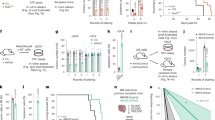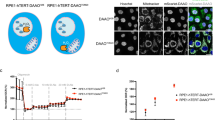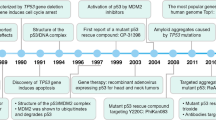Abstract
Nuclear factor-kappa B (NF-κB) inhibits cell death through suppression of the caspase cascade, the c-Jun N-terminal kinase (JNK) pathway, and reactive oxygen species (ROS) accumulation. To suppress this antiapoptotic function of NF-κB might be a promising strategy to increase susceptibility of tumor cells to stress-induced cell death. We have recently shown that tumor necrosis factor (TNF)α induces caspase-dependent and -independent JNK activation and ROS accumulation in cellular FLICE-inhibitory protein (c-Flip)−/− murine embryonic fibroblasts (MEFs). To apply this observation to tumor therapy, we knocked down c-FLIP by RNA interference in various tumor cells. Consistent with the results using c-Flip−/− MEFs, we found that TNFα stimulation induced caspase-dependent prolonged JNK activation and ROS accumulation, followed by apoptotic and necrotic cell death in various tumor cells. Furthermore, TNFα and Fas induced the cleavage of mitogen-activated protein kinase/ERK kinase kinase (MEKK)1, resulting in generation of a constitutive active form of MEKK1 leading to JNK activation in c-FLIP knockdown cells. Given that ROS accumulation and necrotic cell death enhance inflammation followed by compensatory proliferation of tumor cells, selective suppression of caspase-dependent ROS accumulation will be an alternative strategy to protect cells from ROS-dependent DNA damage and compensatory tumor progression.
This is a preview of subscription content, access via your institution
Access options
Subscribe to this journal
Receive 50 print issues and online access
$259.00 per year
only $5.18 per issue
Buy this article
- Purchase on Springer Link
- Instant access to full article PDF
Prices may be subject to local taxes which are calculated during checkout







Similar content being viewed by others
References
Balkwill F, Coussens LM . (2004). Cancer: an inflammatory link. Nature 431: 405–406.
Barkett M, Gilmore TD . (1999). Control of apoptosis by Rel/NF-κB transcription factors. Oncogene 18: 6910–6924.
Budd RC, Yeh WC, Tschopp J . (2006). c-FLIP regulation of lymphocyte activation and development. Nat Rev Immunol 6: 196–204.
Chang L, Kamata H, Solinas G, Luo JL, Maeda S, Venuprasad K et al. (2006). The E3 Ubiquitin Ligase Itch Couples JNK Activation to TNFα-induced Cell Death by Inducing c-FLIP(L) Turnover. Cell 124: 601–613.
Deng Y, Ren X, Yang L, Lin Y, Wu X . (2003). A JNK-dependent pathway is required for TNFα-induced apoptosis. Cell 115: 61–70.
Djerbi M, Screpanti V, Catrina AI, Bogen B, Biberfeld P, Grandien A . (1999). The inhibitor of death receptor signaling, FLICE-inhibitory protein defines a new class of tumor progression factors. J Exp Med 190: 1025–1032.
Edinger AL, Thompson CB . (2004). Death by design: apoptosis, necrosis and autophagy. Curr Opin Cell Biol 16: 663–669.
Giorgio M, Migliaccio E, Orsini F, Paolucci D, Moroni M, Contursi C et al. (2005). Electron transfer between cytochrome c and p66Shc generates reactive oxygen species that trigger mitochondrial apoptosis. Cell 122: 221–233.
Kamata H, Honda S, Maeda S, Chang L, Hirata H, Karin M . (2005). Reactive oxygen species promote TNFα-induced death and sustained JNK activation by inhibiting MAP kinase phosphatases. Cell 120: 649–661.
Karin M, Lin A . (2002). NF-κB at the crossroads of life and death. Nat Immunol 3: 221–227.
Lee KK, Murakawa M, Nishida E, Tsubuki S, Kawashima S, Sakamaki K et al. (1998). Proteolytic activation of MST/Krs, STE20-related protein kinase, by caspase during apoptosis. Oncogene 16: 3029–3037.
Levine B, Klionsky DJ . (2004). Development by self-digestion: molecular mechanisms and biological functions of autophagy. Dev Cell 6: 463–477.
Levine B, Yuan J . (2005). Autophagy in cell death: an innocent convict? J Clin Invest 115: 2679–2688.
Maeda S, Kamata H, Luo JL, Leffert H, Karin M . (2005). IKKβ couples hepatocyte death to cytokine-driven compensatory proliferation that promotes chemical hepatocarcinogenesis. Cell 121: 977–990.
Medema JP, de Jong J, van Hall T, Melief CJ, Offringa R . (1999). Immune escape of tumors in vivo by expression of cellular FLICE-inhibitory protein. J Exp Med 190: 1033–1038.
Micheau O, Tschopp J . (2003). Induction of TNF receptor I-mediated apoptosis via two sequential signaling complexes. Cell 114: 181–190.
Nakajima A, Komazawa-Sakon S, Takekawa M, Sasazuki T, Yeh WC, Yagita H et al. (2006). An antiapoptotic protein, c-FLIPL, directly binds to MKK7 and inhibits the JNK pathway. EMBO J 25: 5549–5559.
Nakano H, Nakajima A, Sakon-Komazawa S, Piao JH, Xue X, Okumura K . (2006). Reactive oxygen species mediate crosstalk between NF-κB and JNK. Cell Death Differ 13: 730–737.
Nakayama M, Ishidoh K, Kayagaki N, Kojima Y, Yamaguchi N, Nakano H et al. (2002). Multiple pathways of TWEAK-induced cell death. J Immunol 168: 734–743.
Ohsumi Y . (2001). Molecular dissection of autophagy: two ubiquitin-like systems. Nat Rev Mol Cell Biol 2: 211–216.
Pham CG, Bubici C, Zazzeroni F, Papa S, Jones J, Alvarez K et al. (2004). Ferritin heavy chain upregulation by NF-κB inhibits TNFα-induced apoptosis by suppressing reactive oxygen species. Cell 119: 529–542.
Ricci JE, Munoz-Pinedo C, Fitzgerald P, Bailly-Maitre B, Perkins GA, Yadava N et al. (2004). Disruption of mitochondrial function during apoptosis is mediated by caspase cleavage of the p75 subunit of complex I of the electron transport chain. Cell 117: 773–786.
Rudel T, Zenke FT, Chuang TH, Bokoch GM . (1998). p21-activated kinase (PAK) is required for Fas-induced JNK activation in Jurkat cells. J Immunol 160: 7–11.
Saitoh M, Nishitoh H, Fujii M, Takeda K, Tobiume K, Sawada Y et al. (1998). Mammalian thioredoxin is a direct inhibitor of apoptosis signal-regulating kinase (ASK)1. EMBO J 17: 2596–2606.
Sakon S, Xue X, Takekawa M, Sasazuki T, Okazaki T, Kojima Y et al. (2003). NF-κB inhibits TNF-induced accumulation of ROS that mediate prolonged MAPK activation and necrotic cell death. EMBO J 22: 3898–3909.
Tobiume K, Matsuzawa A, Takahashi T, Nishitoh H, Morita K, Takeda K et al. (2001). ASK1 is required for sustained activations of JNK/p38 MAP kinases and apoptosis. EMBO R 2: 222–228.
Tournier C, Hess P, Yang DD, Xu J, Turner TK, Nimnual A et al. (2000). Requirement of JNK for stress-induced activation of the cytochrome c-mediated death pathway. Science 288: 870–874.
Vakkila J, Lotze MT . (2004). Inflammation and necrosis promote tumour growth. Nat Rev Immunol 4: 641–648.
Ventura JJ, Cogswell P, Flavell RA, Baldwin Jr AS, Davis RJ . (2004). JNK potentiates TNF-stimulated necrosis by increasing the production of cytotoxic reactive oxygen species. Genes Dev 18: 2905–2915.
Widmann C, Gerwins P, Johnson NL, Jarpe MB, Johnson GL . (1998). MEK kinase 1, a substrate for DEVD-directed caspases, is involved in genotoxin-induced apoptosis. Mol Cell Biol 18: 2416–2429.
Yeh WC, Itie A, Elia AJ, Ng M, Shu HB, Wakeham A et al. (2000). Requirement for Casper (c-FLIP) in regulation of death receptor-induced apoptosis and embryonic development. Immunity 12: 633–642.
Acknowledgements
We thank Y Gotoh, H Nishina, M Takekawa and T Ueno for providing reagents and helpful discussion. This work was supported in part by Grants-in-Aid for 21st Century COE Research and Scientific Research (B) from Japan Society for the Promotion of Science, Japan, a Grant from Human Frontier Science Program (HFSP), and grants from the Takeda Science Foundation, the Tokyo Biochemical Research Foundation, and NOVARTIS Foundation (Japan) for the Promotion of Science.
Author information
Authors and Affiliations
Corresponding author
Rights and permissions
About this article
Cite this article
Nakajima, A., Kojima, Y., Nakayama, M. et al. Downregulation of c-FLIP promotes caspase-dependent JNK activation and reactive oxygen species accumulation in tumor cells. Oncogene 27, 76–84 (2008). https://doi.org/10.1038/sj.onc.1210624
Received:
Revised:
Accepted:
Published:
Issue Date:
DOI: https://doi.org/10.1038/sj.onc.1210624
Keywords
This article is cited by
-
TGR5 agonist inhibits intestinal epithelial cell apoptosis via cAMP/PKA/c-FLIP/JNK signaling pathway and ameliorates dextran sulfate sodium-induced ulcerative colitis
Acta Pharmacologica Sinica (2023)
-
HBXIP induces anoikis resistance by forming a reciprocal feedback loop with Nrf2 to maintain redox homeostasis and stabilize Prdx1 in breast cancer
npj Breast Cancer (2022)
-
MIND bomb 2 prevents RIPK1 kinase activity-dependent and -independent apoptosis through ubiquitylation of cFLIPL
Communications Biology (2021)
-
trans-Fatty acids facilitate DNA damage-induced apoptosis through the mitochondrial JNK-Sab-ROS positive feedback loop
Scientific Reports (2020)
-
Expression of FADD and cFLIPL balances mitochondrial integrity and redox signaling to substantiate apoptotic cell death
Molecular and Cellular Biochemistry (2016)



